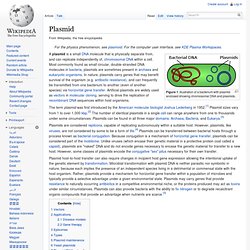

Giant Viruses. The recent discovery of really, really big viruses is changing views about the nature of viruses and the history of life James L.

Van Etten The common view of viruses, mostly true, is of tiny burglars that sneak into cells, grab the biosynthetic controls and compel the cell to make huge numbers of progeny that break out of the cell and keep the replication cycle going. Viruses are supposed to be diminutive even compared to cells that are just a micrometer (1,000 nanometers) in diameter. They are supposed to travel light, making do with just a few well-adapted genes.
In 1992, a new microorganism was isolated from a power-plant cooling tower in Bradford, England, where Timothy Robotham, a microbiologist at Leeds Public Health Laboratory, was seeking the causative agent of a local pneumonia outbreak. Eleven years later, in 2003, the mystery organism received a new identity and a new name, Acanthamoeba polyphaga Mimivirus, for microbe-mimicking virus. » Post Comment Sending... Plasmid (microbiology. Plasmid. Figure 1: Illustration of a bacterium with plasmid enclosed showing chromosomal DNA and plasmids.

Vectors[edit] There are two types of plasmid integration into a host bacteria: Non-integrating plasmids replicate as with the top instance, whereas episomes, the lower example, integrate into the host chromosome. Another major use of plasmids is to make large amounts of proteins. In this case, researchers grow bacteria containing a plasmid harboring the gene of interest. Just as the bacterium produces proteins to confer its antibiotic resistance, it can also be induced to produce large amounts of proteins from the inserted gene.
A plasmid can contain inserts of up to 30-40 kbp. Applications[edit] Disease models[edit] Plasmids were historically used to genetically engineer the embryonic stem cells of rats in order to create rat genetic disease models. Gene therapy[edit] Episomes[edit] In general, in eukaryotes, episomes are closed circular DNA molecules that are replicated in the nucleus. Notes to Deleuze and Guattari’s A Thousand Plateaus: Rhizome, Chapter 1 « Fractal Ontology. Deleuze and Guattari - The Concept of the Rhizome. Rhizomes: Cultural Studies in Emerging Knowledge. Deleuze and Guattari, "Rhizome" annotation by Dan Clinton. Positioned as the introduction to the second volume of Capitalism and Schizophrenia, Rhizome principally constructs a model (a new map) for apprehending the constitution and reception of a book.

As Deleuze writes, “the book is not an image of the world. It forms a rhizome with the world, there is an aparallel evolution of the book and the world” (11). This model, framed metaphorically around rhizomorphism, also extends itself within the text to the study of linguistics and politics. But what is a rhizome, anyway? In the words of the text: “A rhizome as subterranean stem is absolutely different from roots and radicles. Where the potato is the hero of this story, the tree becomes the villain. As such, “Rhizome” rapidly seeks to extinguish every last trace of Hegelianism, particularly from the object of the book: “There is no longer a tripartite division between a field of reality (the world) and a field of representation (the book) and a field of subjectivity (the author).